(Italian pronunciation: pa-lat-soh cap-poh-nee)
Via de’ Bardi, 36
Via de’ Bardi begins one block west of Ponte Vecchio.
[The modern sculpture of St. John the Baptist stands at the western
entrance to the street.]
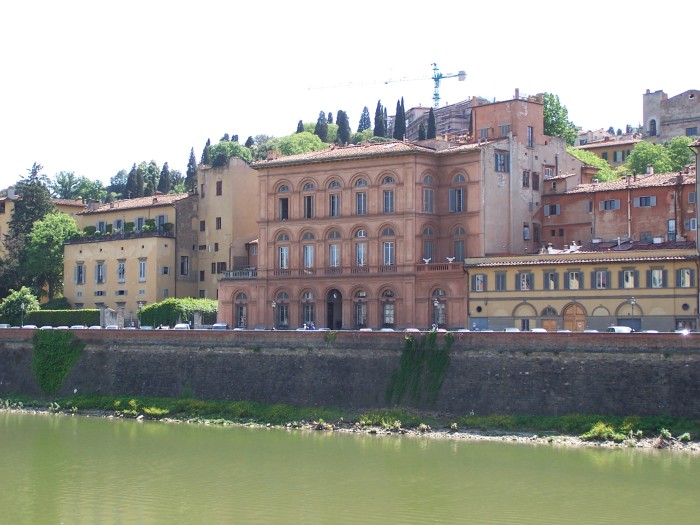
Via de’ Bardi, 36
Via de’ Bardi begins one block west of Ponte Vecchio.
[The modern sculpture of St. John the Baptist stands at the western
entrance to the street.]

Construction of the Capponi palace on via dei Bardi was begun in approximately 1411 by Niccolò da Uzzano. [Donatello is the supposed sculptor of the bust of him housed in the Bargello. The building was called Palazzo Capponi delle Rovinate - meaning "of the ruins"- because it was surrounded by the ruins of other dwellings that had collapsed from erosion on this street fronting the river Arno. Building was likely completed by 1423.
The courtyard at the center of the house (which used to be entirely open and is now enclosed) is the first known example of a Renaissance courtyard. There is speculation that the courtyard was kept open because it is situated across the river from the Palazzo Vecchio which was the seat of Medici power. This view gave visitors to Palazzo Capponi a clear visual reminder of the family’s alliance with the Medici.
Inside the Palazzo Capponi today is one of Florence’s most impressive private art collections. The Grand Salon, with its vaulted ceilings, includes four portraits of the Medici, painted by Sustermans in the 17th century and two huge scenic paintings by Salvator Rosa. In this room are also a portrait of the Senator Giovanni Battista Capponi and a terra cotta bust of Ludovico, the Elder, from whom the current owner is a direct descendant. [Niccolò Capponi’s youngest daughter is named Ludovica.]
The silk in the Red Room came from the Capponi’s own workshops, a sample of the family’s long association with the business of silk trade and production. The private chapel, near to the Red Room, includes a fresco from the 15th Century that is original to the house and a stained glass window done by Guillaume de Marcillat - whose glass work also adorned the Sistine Chapel, until it was destroyed during the Sack of Rome in 1527.
| Excerpts from the Book
Hannibal, Thomas Harris |
 |
|
Pazzi, puffing from the descent, found a place shadowed from the streetlight, an apartment entrance across from the palazzo. If someone came along he could turn and pretend to press a bell.
The palazzo was dark. Pazzi could make out above the great double doors the red light of a surveillance camera. He could not be sure if it worked full-time, or served only when someone rang the bell. It was well within the covered entrance. Pazzi did not think it could see along the façade.
He waited a half-hour, listening to his own breath, and the doctor did not come. Perhaps he was inside with no lights on.
The street was empty. Pazzi crossed quickly and stood close against the wall.
Faintly, faintly a thin sound from within. Pazzi leaned his head against the cold window bars to listen. A clavier, Bach’s Goldberg Variations well played.
Pazzi must wait, and lurk and think. This was too soon to flush his quarry. He must decide what to do. He did not want to be a fool again. As he backed into the shadow across the street, his nose was last to disappear.
The Christian martyr San Miniato picked up his severed head from the sand of the Roman amphitheater in Florence and carried it beneath his arm to the mountainside across the river where he lies in his splendid church, tradition says.
Certainly San Miniato's body, erect or not, passed en route along the ancient street where we now stand, the Via de' Bardi. The evening gathers now and the street is empty, the fan pattern of the cobbles shining in a winter drizzle not cold enough to kill the smell of cats. We are among the palaces built six hundred years ago by the merchant princes, the kingmakers and connivers of Renaissance Florence. Within bow-shot across the Arno River are the cruel spikes of the Signoria, where the monk Savonarola was hanged and burned, and that great meat house of hanging Christs, the Uffizi museum.
These family palaces, pressed together in an ancient street, frozen in the modern Italian bureaucracy, are prison architecture on the outside, but they contain great and graceful spaces, high silent halls no one ever sees, draped with rotting, rain-streaked silk where lesser works of the great Renaissance masters hang in the dark for years, and are illuminated by the lightning after the draperies collapse.
Here beside you is the palazzo of the Capponi, a family distinguished for a thousand years, who tore up a French king’s ultimatum in his face and produced a pope.
The windows of the Palazzo Capponi are dark now, behind their iron grates. The torch rings are empty. In that pane of crazed old glass is a bullet hole from the 1940s. Go closer. Rest your head against the cold iron as the policeman did and listen. Faintly you can hear a clavier. Bach’s Goldberg Variations played, not perfectly, but exceedingly well, with an engaging understanding of the music. Played not perfectly, but exceedingly well; there is perhaps a slight stiffness in the left hand.
If you believe you are beyond harm, will you go inside? Will you enter this palace so prominent in blood and glory, follow your face through the web-spanned dark, toward the exquisite chiming of the clavier? The alarms cannot see us. The wet policeman lurking in the doorway cannot see us. Come . . .
Inside the foyer the darkness is almost absolute: A long stone staircase, the stair rail cold beneath our sliding hand, the steps scooped by the hundreds of years of footfalls, uneven beneath our feet as we climb toward the music.
The tall double doors of the main salon would squeak and howl if we had to open them. For you, they are open. The music comes from the far, far corner, and from the corner comes the only light, light of many candles pouring reddish through the small door of a chapel off the corner of the room.
Cross to the music. We are dimly award of passing large groups of draped furniture, vague shapes not quite still in the candlelight, like a sleeping herd. Above us the height of the room disappears into darkness.
The light glows redly on an ornate clavier and on the man known to Renaissance scholars as Dr. Fell, the doctor elegant, straight-backed as he leans into the music, the light reflecting off his hair and the back of his quilted silk dressing gown with a sheen like pelt.
The raised cover of the clavier is decorated with an intricate scene of banquetry, and the little figures seem to swarm in the candlelight above the strings. He plays with his eyes closed. He has no need of the sheet music. Before him on the lyre-shaped music rack of the clavier is a copy of the American trash tabloid the National Tattler. It is folded to show only the face on the front page, the face of Clarice Starling.
Our musician smiles, ends the piece, repeats the saraband once for his own pleasure and as the last quill-plucked string vibrates to silence in the great room, he opens his eyes, each pupil centered with a red pinpoint of light. He tilts his head to the side and looks at the paper before him.
He rises without sound and carries the American tabloid into the tiny, ornate chapel built before the discovery of America. As he holds it up to the light of the candles and unfolds it, the religious icons above the altar seem to read the tabloid over his shoulder, as they would in a grocery line. The type is seventy-two-point Railroad Gothic. It says “DEATH ANGEL: CLARICE STARLING: THE FBI’S KILLING MACHINE.”
Faces painted in agony and beatitude around the altar fade as he snuffs the candles. Crossing the great hall he has no need of light. A puff of air as Dr. Hannibal Lecter passes us. The great door creaks, closes with a thud we can feel in the floor. Silence.
Footsteps entering another room. In the resonances of this place, the walls feel closer, the ceiling still high – sharp sounds echo late from above – and the still air holds the smell of vellum and parchment and extinguished candlewicks. . .
The rustle of paper in the dark, the squeak and scrape of a chair. Dr. Lecter sits in a great armchair in the fabled Capponi Library. His eyes reflect light redly, but they do not glow red in the dark, as some of his keepers have sworn they do. The darkness is complete. He is considering. . . .
It is true that Dr. Lecter created the vacancy at the Palazzo Capponi by removing the former curator—a simple process requiring a few seconds' work on the old man and a modest outlay for two bags of cement--but once the way was clear he won the job fairly, demonstrating to the Belle Arti Commission an extraordinary linguistic capability, sight-translating medieval Italian and Latin from the densest Gothic black-letter manuscripts.
He has found a peace here that he would preserve--he has killed hardly anybody, except his predecessor, during his residence in Florence.
His appointment as translator and curator of the Capponi Library is a considerable prize to him for several reasons:
The spaces, the height of the palace rooms, are important to Dr. Lecter after his years of cramped confinement. More important, he feels a resonance with the palace; it is the only private building he has ever seen that approaches in dimension and detail the memory palace he has maintained since youth.
In the library, this unique collection of manuscripts and correspondence going back to the early thirteenth century, he can indulge a certain curiosity about himself.
Dr. Lecter believed, from fragmentary family records, that he was descended from a certain Giuliano Bevisangue, a fearsome twelfth-century figure in Tuscany, and from the Machiavelli as well as the Visconti. This was the ideal place for research. . .
Now we can see Dr. Lecter seated at a sixteenth century refectory table in the Capponi Library. Behind him is a wall of pigeonholed manuscripts and great canvas-covered ledgers going back eight hundred years. A fourteenth-century correspondence with a minister of the Republic of Venice is stacked before him, weighted with a small casting Michelangelo did as a study for his horned Moses, and in front of the inkstand, a laptop computer with on-line research capability through thee University of Milan.
His appointment as translator and curator of the Capponi Library is a considerable prize to him for several reasons:
The spaces, the height of the palace rooms, are important to Dr. Lecter after his years of cramped confinement. More important, he feels a resonance with the palace; it is the only private building he has ever seen that approaches in dimension and detail the memory palace he has maintained since youth.
In the library, this unique collection of manuscripts and correspondence going back to the early thirteenth century, he can indulge a certain curiosity about himself.
Dr. Lecter believed, from fragmentary family records, that he was descended from a certain Giuliano Bevisangue, a fearsome twelfth-century figure in Tuscany, and from the Machiavelli as well as the Visconti. This was the ideal place for research. While he had a certain abstract curiosity about the matter, it was not ego-related. Dr. Lecter does not require conventional reinforcement. His ego, like his intelligence quota, and the degree of his rationality, is not measurable by conventional means.
In fact, there is no consensus in the psychiatric community that Dr. Lecter should be termed a man. He has long been regarded by his professional peers in psychiatry, many of whom fear his acid pen in the professional journals, as something entirely Other. For convenience they term him "monster."
The monster sits in the black library, his mind painting colors on the dark and a medieval air running in his head. He is considering the policeman.
Click of a switch and a low lamp comes on.
Now we can see Dr. Lecter seated at a sixteenth-century refectory table in the Capponi Library. Behind him is a wall of pigeonholed manuscripts and great canvas-covered ledgers going back eight hundred years. A fourteenth-century correspondence with a minister of the Republic of Venice is stacked before him, weighted with a small casting Michelangelo did as a study for his horned Moses, and in front of the inkstand, a laptop computer with on-line research capability through the University of Milan.
Bright red and blue among the dun and yellow piles of parchment and vellum is a copy of the National Tattler. And beside it, the Florence edition of La Nazione.
Dr. Lecter selects the Italian newspaper and reads its latest attack on Rinaldo Pazzi, prompted by an FBI disclaimer in the case of Il Mostro. "Our profile never matched Tocca," an FBI spokesman said.
La Nazione cited Pazzi's background and training in America, at the famous Quantico academy, and said he should have known better.
The case of Il Mostro did not interest Dr. Lecter at all, but Pazzi's background did. How unfortunate that he should encounter a policeman trained at Quantico, where Hannibal Lecter was a textbook case.
When Dr. Lecter looked into Rinaldo Pazzi's face at the Palazzo Vecchio, and stood close enough to smell him, he knew for certain that Pazzi suspected nothing, even though he had asked about the scar on Dr. Lecter's hand. Pazzi did not even have any serious interest in him regarding the curator's disappearance.
The policeman saw him at the exposition of torture instruments. Better to have encountered him at an orchid show.
Dr. Lecter was well aware that all the elements of epiphany were present in the policeman's head, bouncing at random with the million other things he knew.
Should Rinaldo Pazzi join the late curator of the Palazzo Vecchio down in the damp? Should Pazzi's body be found after an apparent suicide? La Nazione would be pleased to have hounded him to death.
Not now, the monster reflected, and turned to his great rolls of vellum and parchment manuscripts.
Dr. Lecter does not worry. He delighted in the writing style of Neri Capponi, banker and emissary to Venice in the fifteenth century, and read his letters, aloud from time to time, for his own pleasure late into the night.
| From the Website:
The Making of the Movie, Hannibal |
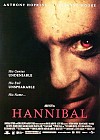 |
|
Ridley is ready to roll on the first shot which is of Giancarlo approaching an empty row of chairs and taking a seat behind a man named Ricci who gives him a report on the proceedings. At the front of the room, a group of men are seated at a long table, arguing the formalized way that is peculiar to academics. I recognize one of these men as Count Niccolò Capponi. The most loudly contentious is a character named Sogliato who challenges this committee’s selection for curatorship of the Caponni library of Dante manuscripts and correspondence. Scene in the Palazzo Vecchio
Friday, May 5
This Palazzo is one of five Florentine palaces belonging to one of the city’s oldest royal families. This morning, cameras are set up around a piano in the "Red Room," so called because of the blood red silk curtains along the wall. Today, it is Dr. Fell’s library.
Dr. Fell is seated on the piano bench [he plays the harpsichord in the novel] at the center of the room. A half turn to allow wardrobe assistant Amanda Trewin to adjust his lapels and shirt cuffs, brings the doctor’s unmistakable profile into the light.
Amanda finishes quickly and Sir Anthony Hopkins again squares himself in front of the keyboard. A classically trained pianist, he idly runs through scales and fragments of a few concertos. The noise level in the room is high and he plays too softly for anyone to hear clearly from more than a few feet away.
Tony’s back is to the Grand Salon where those of us not involved in this setup are packed safely out of way. I’m standing not far from a tall, distinguished man who is smoking a pipe. He can’t be an actor – since the scene involves only Dr. Fell/Hannibal. He is not a guest of Martha or Dino who sit beside Branko at the bank of monitors (run by video operator, Lester Dunton) in an adjacent ante-room. Austere and neatly tailored, he is definitely not one of the crew - who are mostly dressed in tee-shirts and shorts on this warm spring day.
Lowering his pipe, the distinguished man, around forty years old, gives a slight, courtly bow and introduces himself as Count Niccolò Capponi. . . .
One of the main reasons we are filming at this location is the fact that Thomas Harris enlisted Niccolò’s help in researching his book and subsequently set some of the novel in the Palazzo Capponi. Niccolò provided reference materials and historical information and Harris paid tribute by using the real family name - in a fictional context, of course.
"It is fascinating to see a scene that Thomas describes in his book become three-dimensional right here in front of us," comments the Count.
Other Places filmed in Hannibal
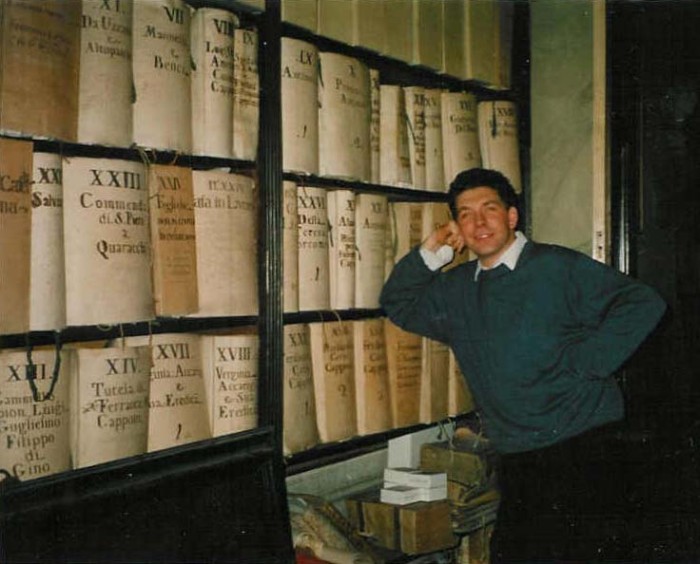
The Capponi Library
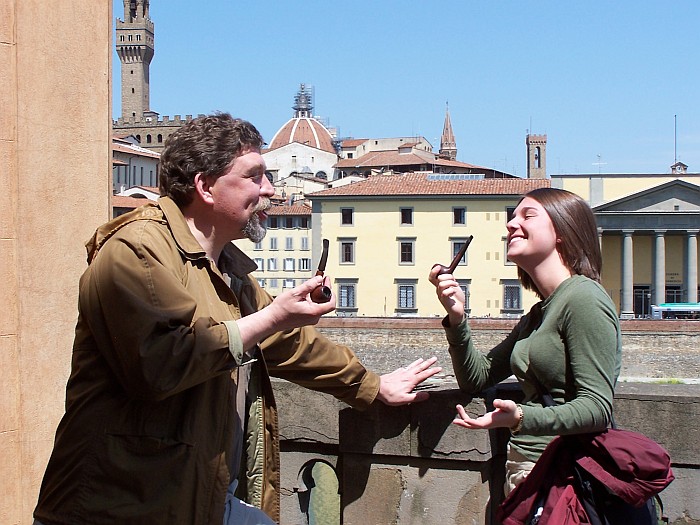
Jessica Maves (Political Science) discusses Florentine politics with Dottore Niccolò Capponi on the balcony of the historic Palazzo Capponi. Pipe is mandatory for any chance of intelligent conversation.
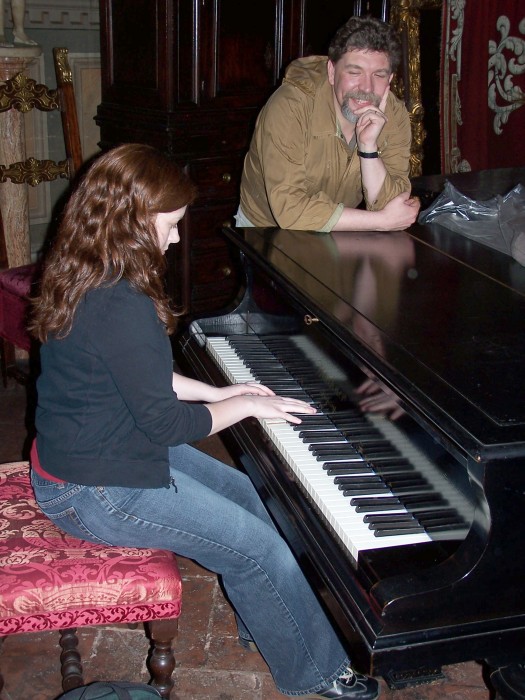
Count Capponi listens to Marie Heiniger (Music) play Mozart on his Blüthner piano.
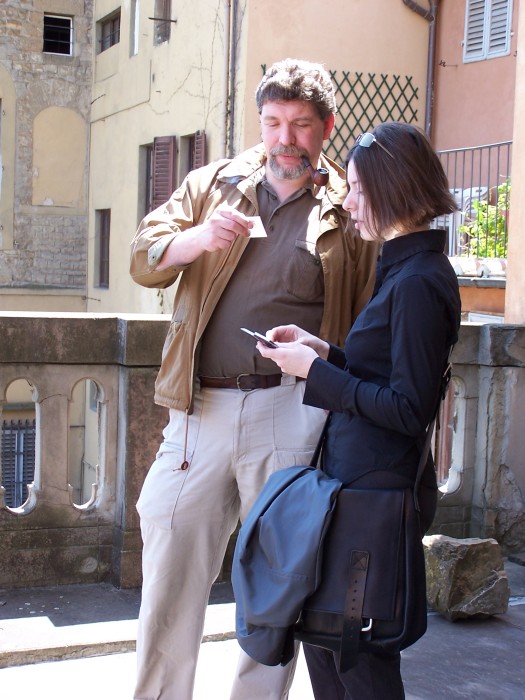
Professore Capponi admires the artwork of Sara Vouthilak (Graduate Student)
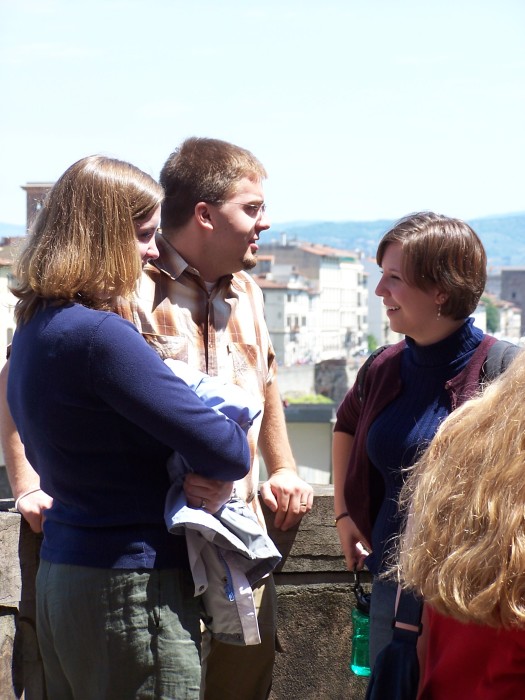
The Slaters, Ashley and Justin (both in Mechanical Engineering) ponder
with Jennifer Pitkin (Family and Consumer Science), whose husband Matt
is not shown), what married life would be living in a palazzo such as this.